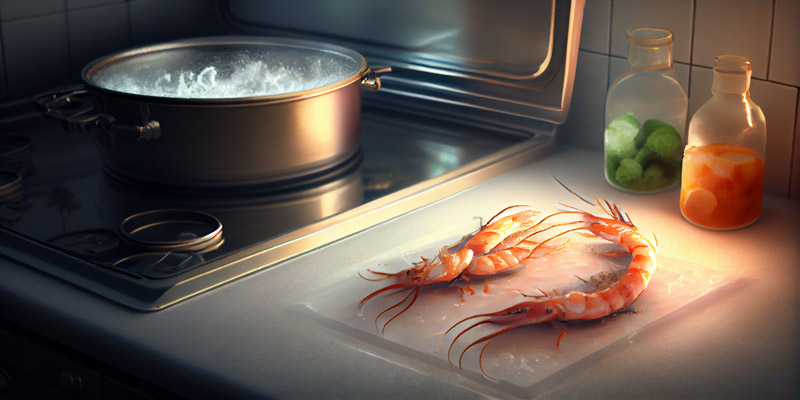Prawns are such a versatile food. Tender and juicy, they blend into various dishes from pan-seared with spices and hearty stews to Grilled Shrimp Scampi.
As someone who cooks them often, I store both fresh and cooked shrimp. If your family loves seafood, you‘d want to batch cook them and store them in the freezer.
Have you ever wondered whether you can reheat cooked frozen prawns?
Yes, absolutely! You can reheat prawns from baby-sized to jumbo, with proper handling.
How To Reheat Frozen Cooked Prawns?
Basically, thawed cooked shrimp can be heated again in several ways.
Irrespective of the method you choose, ensure they are heated up to the correct temperature and are completely and evenly warmed up. This is essential to avoid the growth of bacteria and to prevent food poisoning.
When checked with a food thermometer, the internal temperature should register at least 165°F (74°C) before you can serve it. This applies to all kinds of meat dishes, not just seafood.
Reheat the prawns, preferably not more than a couple of times, using the stovetop, oven, microwave, air fryer, slow cooker, or Instant pot.
Why Should You Thaw Cooked Frozen Prawns?
Thawing is the process that allows food to gradually come to room temperature. This causes fewer abrupt changes in the internal temperature of the meat.
When you thaw foods before cooking or reheating them, you allow for the flavor and texture to be retained. This also stops the prawns from drying up or becoming rubbery after reheating.
Let’s find out how to reheat with each of these cooking methods.
Stovetop method:
Add the thawed prawns to a saucepan. Add a small amount of broth or water to prevent them from drying out. Cover with a lid and heat it up over medium heat. stirring occasionally, until heated through.
Oven method:
Preheat your oven to 375°F (190°C) and place the frozen prawns in a baking dish. Cover the dish with foil and reheat for about 10 to 15 minutes, or until heated through. You can also reheat at 350°F (175°C) for 20 to 25 minutes.
Microwave method:
Place the frozen prawns in a microwave-safe dish and cover with a lid or microwave-safe wrap. Heat on high in 1-minute intervals, stirring in between until the prawns are heated through.
Slow Cooker:
A slow cooker can be a good option for reheating frozen prawns, especially if you prefer a low-heat, hands-off approach. The slow and gentle heat of a slow cooker can help to evenly and thoroughly reheat the prawns without drying them out.
To reheat frozen prawns in a slow cooker, simply add the prawns to the slow cooker along with any sauce or liquid. Cover and cook on low heat for 1 to 2 hours, or until heated through.
As slow cookers can vary in cooking time and temperature, adjust the settings for your specific model.
Instant Pot:
The high pressure and quick cooking time of an Instant Pot can quickly and thoroughly reheat the prawns, preserving their texture and flavor.
To reheat frozen prawns in an Instant Pot, simply add the prawns to the Instant Pot along with any sauce or liquid. Close the lid and set the Instant Pot to "Steam" mode for 2 to 3 minutes, or until heated through.
As slow cookers can vary in cooking time and temperature, adjust the settings for your specific model.
Related: If you want to know whether you can reheat other foods, read How to Reheat Olive Garden Breadsticks [Best 3 Methods]
Can Frozen and Cooked Prawns be Reheated Without Thawing?
Yes, you can directly reheat frozen cooked prawns without thawing them first. However, it is important to handle the prawns properly to ensure that they are heated thoroughly and safely.
Moreover, this direct way of warming up food results in uneven cooking and takes much longer to heat up. Parts of the prawn dish will be overdone while the other part remains undercooked.
The texture and flavor of the meat are less than perfect when reheated without proper thawing.
Tips on reheating cooked frozen prawns without thawing
If you do reheat frozen food directly, use low and slow cooking methods with a slow cooker, microwave, or oven.
You can use the low temperature and longer cooking time settings. Stir the prawns a couple of times during cooking to ensure it is reheating evenly.
- Reheat for 1 to 2 hours on low heat in the slow cooker.
- Reheat it for about 20 to 25 minutes in the oven at 350°F (175°C).
- Reheat it in the microwave at medium in 2-minute intervals. Stir between reheating cycles, until heated through.
How to safely reheat cooked and frozen prawns?
Do avoid reheating frozen prawns more than once, and definitely not more than two times.
If you want to freeze a big batch and reheat them over the next couple of weeks or months, there is a much more prudent way to go about it.
Freeze cooked prawns in smaller quantities. Simply thaw out only the amount you need to serve or add to another dish.
You may also like: How to freeze potatoes without blanching
Can You Reheat Thawed Cooked Prawns Stored in the Fridge?
Yes, you can. Ensure your prawn pilaf or grilled prawns have not been sitting in the fridge for more than 1 to 3 days after thawing.
Follow the same steps mentioned in the section on cooking methods.
Quick Note: While this is simply a suggestion, reheat thawed prawns as soon as possible to retain texture and flavor. You can prevent food illness-causing bacteria from multiplying.
Can You Reheat Frozen Prawn Food Multiple Times?
Avoid reheating frozen or refrigerated cooked food multiple times. The frequent refreezing, thawing, chilling and reheating causes a lot of change in temperatures.
This can help inactive bacteria to multiply and increase your risk of ending up with a nasty stomach bug.
Avoid reheating them more than one or two times and always ensure you reheat them well.
Consume the prawns quickly, keep them in a warm mode for a couple of hours, or cool and refrigerate them to serve later on.
If you have doubts about the quality of your reheated prawns, throw them away rather than risk contamination and resulting health issues.
Steps to Refreeze Thawed and Reheated Prawns
- Add the cooled prawns to one or more freezer bags or containers.
- If the prawns have been cooked into a curry or with a sauce, store the liquids separately in freezer-safe jars or containers.
- Avoid overfilling and leave some space at the top. Squeeze all the air out from the bag.
- Seal the bag or container tightly. Vacuum seal the bag if you can. You can cover the sealed bag with another one to prevent ice crystals from forming.
- Label the bag or container and store it at the back of the freezer for up to a month.
You can also add refreeze prawn dishes by adding them to a cookie sheet. Once frozen remove the sheet and transfer the contents to freezer bags.
Final Thoughts
You can reheat any type of frozen cooked prawn or shrimp. They can be directly reheated or thawed and then heated to the right temperature to ensure even cooking.
Reheated cooked prawns can be refrozen after cooling. But avoid reheating and freezing more than one or two times. Doing so helps you stay away from food-borne illnesses and stops the prawn meat from turning toxic.
Gravy-based prawns are usually frozen in separate containers. Heat them together in a saucepan after you have thawed them.
Keep thawed prawns in the fridge for a couple of days before you reheat or refreeze them.
This guide has provided all the information you need to reheat cooked prawns that were previously frozen and thawed.
Frequently Asked Questions
Can you reheat prawns that were thawed and then frozen?
Yes, you can reheat prawns that have been thawed and then frozen, but it's important to handle them properly to minimize the risk of food poisoning.
Can you thaw frozen prawns at room temperature?
No. Thaw your prawns in the refrigerator for the safest way. Whenever you want to cook them, take a bag out from the freezer and thaw them overnight in the fridge.
For quicker thawing, defrost the prawns in the microwave or place them in a bowl of cold water.

